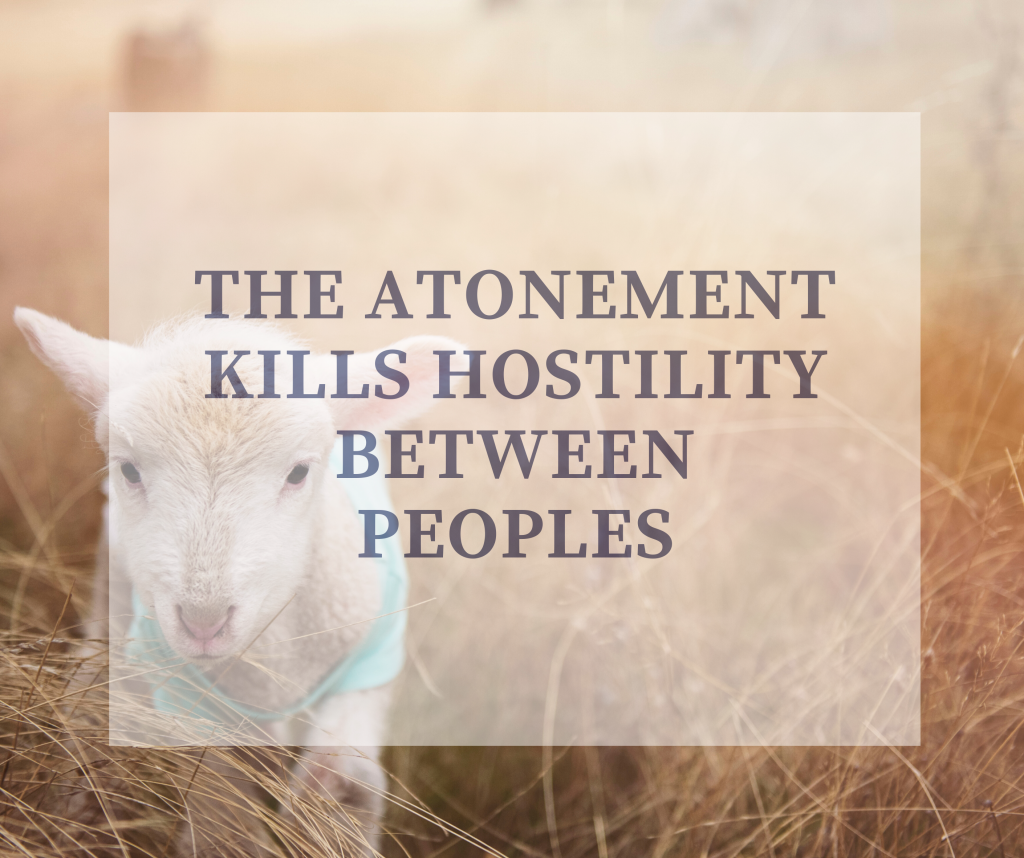Six ways the Bible undermines racism: (#2) The atonement kills hostility between peoples
This is my second post in a series on how the gospel of Christ offers a cure to the pathologies of racism and tribalism. My first post in the series, “All Gentiles are born ‘strangers and aliens’”, is here. A small part of this second post is adapted from my forthcoming article in Missio Dei Journal: “An Honor-Bearing Gospel for Shame-Fueled Crises.”

13But now in Christ Jesus you who once were far off have been brought near by the blood of Christ. 14For he himself is our peace, who has made us both one and has broken down in his flesh the dividing wall of hostility 15by abolishing the law of commandments expressed in ordinances, that he might create in himself one new man in place of the two, so making peace, 16and might reconcile us both to God in one body through the cross, thereby killing the hostility. –Ephesians 2:13–16 ESV
Four verses on what Christ’s atonement accomplishes
In Ephesians 2:13–16 Paul proclaims a stunning truth: The cross kills hostility (Eph 2:16). The default hostility between Jew and Gentile is plain in these verses. Somehow the atonement of Christ makes it possible to resolve this conflict.
Once far off, now brought near
Verse 13. The phrase “But now in Christ Jesus, you who were once far off …” (Eph 2:13) is like saying, You Gentiles were distant from God’s people. You and your people were so very different from my people. This distance between us made us natural enemies. But now, in King Jesus, “you have been brought near by the blood of Christ” (Eph 2:13).
The crucifixion of Jesus did something world-altering in the social realm. Being “in Christ” is not merely an individual, vertical, largely internal and invisible, spiritual reality. Being “in Christ” is also about who we are (plural) right now, right here. It is likewise a spiritual reality that is social, horizontal, external, public, and visible. This happens “by the blood of Christ (Eph 2:13).”
Timothy Tennent writes: “The New Testament celebrates a salvific transformation that has both vertical and horizontal dimensions. Personal salvation in the New Testament is inextricably linked to becoming a part of the new humanity of Ephesians 2:15.”1
The gospel has a social dimension because the atonement has a social dimension.
The gospel truth: The atonement transforms both the individual-vertical and social-horizontal arenas of human life.
The crucified-and-risen Christ is our peace
Verse 14. When Paul writes, “For he himself is our peace,” it is understood that without Christ, conflict prevails. Hostility between peoples is humanity’s default. The phrase “who has made us both one” is not referring to two persons in conflict. It refers to two groups, Jews and Gentiles, in conflict. Paul is saying I belong to the Jews (collectively); and you (collectively) are the Gentiles. (See the post on HonorShame.com, “In Christ as a Communal Ethic,” which offers a fuller explanation.)
This making “us both one” is only possible because Christ has “broken down in his flesh the dividing wall of hostility.” Paul is saying that when Christ’s body was crucified, something was broken “in his flesh.” That something is “the wall of hostility.” Somehow the atonement of Jesus the Christ breaks down walls of conflict between Jew and Gentile peoples “in Christ.”
But God is doing more than offering reconciliation to Jews and Gentiles. God’s purpose is “to unite all things in him” (Eph 1:10), and “to reconcile to himself all things, whether on earth or in heaven, making peace by the blood of his cross” (Col 1:20). Any conflict between peoples, any racial hostility, can be resolved in the Christ who is “our peace”—people together giving their allegiance to King Jesus.
The gospel truth: The atonement breaks down walls of hostility between peoples.
Abolishing values that fuel tribalism and segregation
Verse 15. “by abolishing the law of commandments expressed in ordinances, that he might create in himself one new man in place of the two, so making peace” (Eph 2:15). What does this have to do with atonement? We find clarification in Colossians 2:14: “by canceling the record of debt that stood against us with its legal demands. This he set aside, nailing it to the cross.” Christ “abolishing the law of commandments” (Eph 2:15) overlaps with Christ “canceling the record of debt that stood against us with its legal demands” by “nailing it to the cross” (Col 2:14).
The law in the Old Testament was not only the moral law of God. The law also consisted of regulations that were more cultural in nature (such as food guidelines), and contributed to the “wall of hostility” between the Jews and the non-Jews (Gentiles). Mark Roberts writes, “The death of Christ has supplanted the law, and therefore all people can belong to God through faith because of his grace in Christ.”2 Cultural differences that are the basis for division, conflict, and hostility are subsumed in the crucifixion and resurrection of the man Jesus the Christ.
The gospel truth: The atonement nails to the cross cultural regulations or values that are the basis for tribal or racial separation.
The “one new man”—who is this?
More on verse 15. “that he might create in himself one new man in place of the two, so making peace.” Who is this “one new man”? What is this new way of being human?
This is the kingdom-of-God program of identity formation. In Ephesians 2:19, God is democratizing honor for believers—insider status is available to all who give their allegiance to the Christ. This “one new man” (Eph 2:15), this new way of being human, relativizes every other form of social capital. Even racial identity is somehow absorbed into Christ. Roberts writes:
Recall that the recipients of the letter were … Gentiles “by birth” (literally “in flesh,” en sarki). These Gentiles did not become Jewish when they received God’s grace through Christ. Rather, Christ made them into something different from ordinary Gentiles and Jews. The early Christian writing known as the Epistle to Diognetus expresses this same point when it calls Christians a new race, “neither Jewish nor Gentile.”3
The Epistle to Diognetus calls Christians a new race, neither Jewish nor Gentile. This is an arresting thought. It informs how we think about the phrase “one new man” (Eph 2:15), hena kainon anthropon in the Greek. The phrase is also translated “one new humanity” (NIV), and “one new people” (NLT). Believers from Jewish backgrounds as well as Gentile backgrounds, believers from every social class together, gain not merely the ultimate insider status—“members of the household of God” (Eph 2:19); Christ-followers also gain a new core identity.
Could it be—the influence of Jesus Christ on who we are is so fundamental, it’s almost like gaining a new racial identity?
McNall captures the essence of this new identity. “This transformation [by the reconciling cross of Christ] is seen … in the tearing down of ethnic and cultural boundaries (‘the dividing wall of hostility’ [2:14]). This demolition results in a new community comprised of a new people who do not look like they belong together. Only Jesus and his spirit can account for this strange lot.”4
The gospel truth: The atonement creates a new way of being human—a new identity in Christ that’s like “a third race.”
That strange phrase—“killing the hostility”
Verse 16. “and might reconcile us both to God in one body through the cross, thereby killing the hostility” (Eph 2:16). Somehow, the brutal violence of the crucifixion of Jesus the Christ kills the hostility between “us both.” Paul is getting personal again when he says “us both” (Eph 2:14, 16). He himself is part of a collective identity (Jewish) needing reconciliation in Christ “to God in one body”—with another collective identity (Gentile).
These two groups are separated and segregated. Although they live in the same city, they are not in the same neighborhood. They generally do not live together, play together, or worship together. They do not intermarry. They have different physical features, There are hundreds of years of hostility between them. Their politics and cultures compete, sometimes violently. They are suspicious of each other.
But Paul says when persons and peoples give allegiance to Jesus the Christ—the One who was brutally crucified, the One who then rose from the dead and was exalted as king of kings—something glorious happens. The atonement of Christ is “killing the hostility.” This verse is in the active, present-tense voice as though the Christ-event, which happened two thousand years ago, is impacting humanity into our present days and forward into the future.
Reconciliation between peoples in conflict is not merely a dream. Reconciliation is embodied in the man Jesus Christ and his body crucified and risen again. Peace is possible. Paul boldly imagines a new humanity, “one new man” (Eph 2:15), a “third race,” embodied in Christ. The core identity of this body is neither Jew nor Gentile, neither red or yellow, black or brown or white. It is not that cultural distinctions are obliterated. It is that Jesus the Christ is so glorious and so magnified in our social relations that the walls of separation and hostility dissolve. Paul envisions this as the new normal.
The gospel truth: The atonement kills hostility between peoples.
Toward a social imagination based on Ephesians 2
What are we being called to believe? That the cross kills all hostility in the here-and-now? No, we are not called to magical thinking. I recommend three “steps of belief.”
The cross kills hostility—step 1: The social hostility between Jewish and Gentile peoples (although in some cases commanded by the Old Testament) was in some measure conquered by the violence of the cross. Peace is possible—now—through the “new humanity” (Eph 2:15). Traditionally at odds with one another, Jews and Gentiles really can worship in unity through their common faith in Jesus the Christ, despite cultural and racial differences.
The cross kills hostility—step 2: This biblical truth extends to any and all peoples in conflict, since the plan of God “for the fullness of time” is to “unite all things in him” (Eph 1:10), to “reconcile to himself all things . . . making peace by the blood of his cross” (Col 1:20). We see that this applies globally for all families, peoples, and nations. It is a sure hope for the future—an eschatological hope.
The cross kills hostility—step 3: In the third step, we dream. This dream stage is a call for Christians to develop a social imagination that is informed by Ephesians 2. It is a vision that, as Timothy Gombis says, “includes and celebrates racial, ethnic and gender differences . . . [whereby] no singular gender, ethnicity or race is any closer to God than any other. We are all one in Christ and are now free to explore the gifts that each group brings to the kingdom party.”5 This step combines the “now” of step 1 with the “whole-world hope” of step 2. Could it be that the pathologies of racism and tribalism may in some measure be cured by the atonement of Christ “killing the hostility”?
ACTION POINTS
- Evaluate your view of the atonement. Have you ever considered Ephesians 2:13–16 as part of a comprehensive view of the doctrine of the atonement? Might Ephesians 2:13–16 be just as important as, for example, Romans 3:23–25? Why do you think this Ephesians passage is under-represented in the literature about the atonement? For example, in this best-selling Systematic Theology, an extensive chapter (Ch. 27) is devoted to the doctrine of the atonement. Not one mention is given to Ephesians 2:13–16. In fact, not one time is Eph 2:13–16 cited in the entire volume. This is the case, despite the density of truths concerning “the blood” (Eph 2:13) of Christ, “the cross” of Christ, the emphasis on “his flesh” (Eph 2:14), as well reconciliation and the act of “killing” (Eph 2:16). Is this evidence of a theological blind spot that ignores group identity issues? Does this hint at why the evangelical church struggles with how to address racism and tribalism?
- Teach and preach the gospel based on the atonement truths in Ephesians 2:13–16. Develop a gospel message that calls people to give their allegiance to Christ based primarily on these verses.
- Read a book on the theology of a multiethnic church. See David E. Stevens, God’s New Humanity: A Biblical Theology of Multiethnicity for the Church.
- Discover the theological roots of racism. Begin a journey of discovery about what this means for the global church. See Willie James Jennings, The Christian Imagination: Theology and the Origins of Race.
NOTES
- Timothy C. Tennent, Invitation to World Missions: A Trinitarian Missiology for the Twenty-first Century (Grand Rapids, MI: Kregel), 62.
- Mark D. Roberts, The Story of God Bible Commentary: Ephesians (Grand Rapids: Zondervan), 81.
- Ibid., 77.
- Joshua M. McNall, The Mosaic of Atonement: An Integrated Approach to Christ’s Work. (Grand Rapids: Zondervan, 2019), 243–244.
- Timothy Gombis, The Drama of Ephesians: Participating in the Triumph of God (Downers Grove: InterVarsity, 2010), 103.
originally posted on wernermischke.org
Search the Blog
Free Resource

3 Ways to Honor God on Your Next Mission Trip
We're sharing three things you should consider before you organize or participate in an international mission trip, seek to do work in the multicultural neighborhood in your own city, or embark on any cross-cultural partnership.

